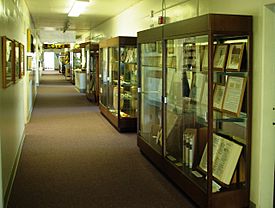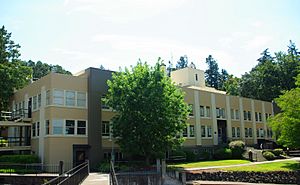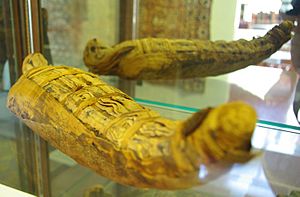Prewitt–Allen Archaeological Museum facts for kids

Display cases at the museum
|
|
| Established | 1950s |
|---|---|
| Location | Salem, Oregon, USA |
| Type | archaeology |
The Prewitt-Allen Archeological Museum is a cool place to learn about ancient history! It's located at Corban University in Salem, Oregon, USA. This museum started in the 1950s. You can find it inside the school's library. It's free to visit!
The museum has over 900 items. Many of these items come from the Eastern Mediterranean region. You can see amazing things like copies of the Rosetta Stone and the Code of Hammurabi. They also have old oil lamps and a special ancient document called a papyrus palimpsest.
Contents
Museum History
How the Museum Started
The idea for the museum began in 1953. A man named Robert Allen wanted to start it. At that time, the school was called Western Baptist Bible College. It was located in California. Robert Allen believed that ancient objects could help him teach his classes.
In 1953, he bought a piece of papyrus. Papyrus is an ancient paper-like material. This piece was from the 5th century A.D. It is now known as the Allen Papyrus.
Collecting Artifacts
In 1964, Robert Allen started a big trip. He traveled around the world for seven years! He visited 39 countries, from the Middle East to Europe. During this journey, he collected many ancient items for the museum. He returned to the college in May 1971.
The museum was first named the Robert S. Allen Archaeology Museum.
Special Research and Growth
In 1975, the Allen Papyrus was loaned out. It went to the California Institute of Technology. Scientists there used special computer software. This software was used to clean up pictures from Mariner probes sent to Mars. They wanted to see if it could help read old writings. These writings had been erased from the papyrus when it was reused.
By 1998, the museum's collection had grown. It had about 600 pieces. Adrian Jeffers became the curator that same year. A curator is someone who manages a museum's collection.
In March 2008, the museum got a full-size copy of King Tut’s mask. King Tut was an ancient Egyptian pharaoh. Later in 2008, a very old Torah scroll was given to the museum. A Torah scroll is a holy book for Jewish people. This scroll was from the mid-1800s. It was about 17 inches tall. It came from what is now Iraq. By 2009, the museum's collection had more than 900 items.
Museum Collections
Where to Find the Museum
The Prewitt–Allen Archaeological Museum is inside the library at Corban University. You'll find the displays on the second floor. They line the hallway of the library. The museum is open during the same hours as the library. It's free to get in!
What You Can See
Most of the artifacts in the museum come from the Eastern Mediterranean Sea region. This area includes countries like Greece, Turkey, Lebanon, Israel, Iraq, and Egypt. It also includes ancient lands like Sumeria, Mesopotamia, and Palestine. The museum says it's the only one of its kind between Vancouver, B.C., and San Francisco.
Everyday Ancient Objects
The museum has a collection of oil lamps. Some of these lamps are from the Bronze Age. This collection shows how lamps changed over time. It includes newer lamps from the Iron Age and Medieval times.
Other everyday items in the museum include:
- Hand tools
- Scrapers
- Pottery
- Arrowheads
- Tear bottles
- Cups (like a kylix, a type of drinking cup)
- Perfume bottles
- Coins
- Clay tablet writings
These items help us understand what life was like long ago. They show how people lived in Egypt, Greece, Palestine, and Mesopotamia.
The Special Palimpsest
One of the most important items is a palimpsest parchment. It's from around 700 A.D. A palimpsest is a document where the original writing was erased. Then, new writing was put on top of the old text.
This artifact has Coptic writing on it. This writing is about the Wisdom of Solomon. But underneath, there are older writings in Greek. These older writings are a list of words from Virgil’s Georgics. This special document is called the Allen Papyrus or Allen Palimpsest. It's named after the museum's founder, Robert Allen, who found it in Egypt. The original writings are from the 5th century A.D.
Oldest and Unique Pieces
The museum has pieces that are very, very old. Some pottery pieces date back to 3000 BC. These are the oldest items in the collection. Other pottery includes a tablet from 2700 B.C. It has writing from Samarian and came from Beersheba. There are also items as recent as the 1st century AD. Another interesting piece is an Amphora. An amphora is a type of ancient jar. This one came from a shipwreck in the Mediterranean Sea.
Ancient Egyptian Displays
You can also see items related to mummification from ancient Egypt. One display shows alabaster Canopic jars. These jars were used to store the internal organs of mummies. They are shaped like a gorilla.
There's also a mummy of a falcon! This falcon mummy is from 1500 BC. It comes with a special casket. The falcon is wrapped to look like Osiris, an Egyptian god.
Amazing Replicas
The museum has several large copies of famous ancient objects.
- A full-size copy of the Rosetta Stone. This copy was made from a mold of the real stone. The Rosetta Stone helped us understand ancient Egyptian hieroglyphs.
- A copy of the Code of Hammurabi. This copy is 6 feet tall! It's based on the laws of the Babylonian King Hammurabi. The laws are carved into black basalt stone.
- Other copies include the Obelisk of Shalmaneser.
- Jewelry of Queen Nefertiti.
- A gold bust of the Pharaoh Tutankhamun.
Besides real artifacts, the museum also has copies of all the pages of the New Testament. These copies are from the main ancient manuscripts of that work.
Museum Namesakes
The museum is named after two important people: Robert S. Allen and Frank Prewitt. Both helped start the museum in the 1950s. This was when the college was in El Cerrito, California.
Frank Prewitt was a professor of Bible at the college for 50 years. Robert Allen was a postal worker. He was also an amateur archeologist. He taught archaeology at the college from 1956 to 1969.



